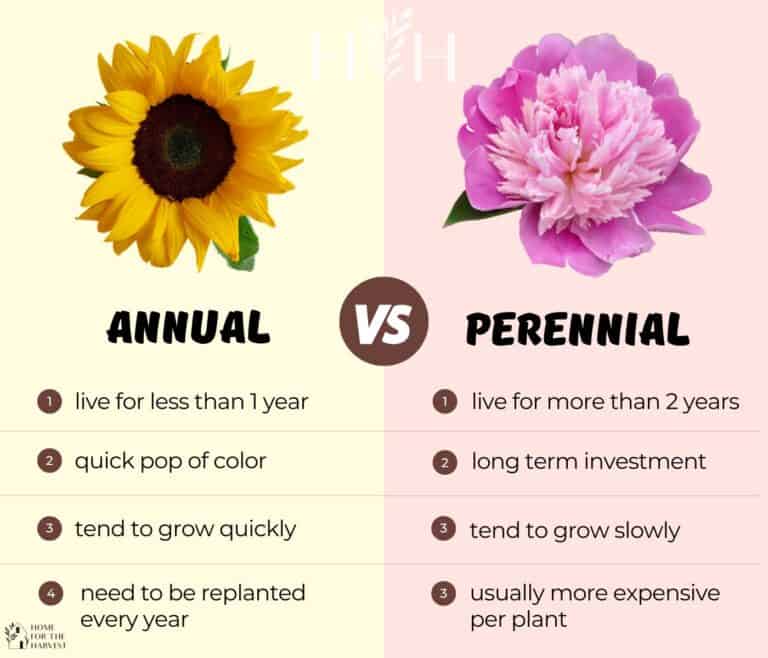Should You Plant Annuals Or Perennials? The Ultimate Comparison

Table of Contents
Understanding Annuals: A Season of Bloom
What are Annuals?
Annual plants complete their life cycle in a single growing season. This means they germinate, grow, flower, produce seeds, and die all within one year. Popular examples of annual flowers include zinnias, petunias, marigolds, and impatiens. These annual plants offer a burst of vibrant color that brightens any garden. Many gardeners appreciate the wide variety of annual flowers available, allowing for diverse annual garden design.
Pros of Planting Annuals:
- Vibrant, consistent color: Annuals provide a continuous display of color throughout the growing season, ensuring your garden always looks its best. This consistent bloom makes them ideal for creating impactful annual flower beds.
- Extensive variety: The sheer range of colors, sizes, and shapes available in annual plants allows for endless creative possibilities in annual garden design. From trailing petunias to towering sunflowers, you can find the perfect annuals to complement your aesthetic.
- Easy experimentation: Because annuals are replaced each year, they offer a great opportunity to experiment with different colors, textures, and plant combinations without a long-term commitment. Try a new arrangement of quick-blooming annuals each spring!
- Quick establishment and bloom: Annuals generally establish quickly and begin blooming soon after planting, providing rapid results for gardeners who want instant impact. This makes them a great option for those who want quick gratification from their annual flower beds.
Cons of Planting Annuals:
- Annual replacement: The biggest drawback is the need to replant annual flowers every year. This can be time-consuming and add to the overall cost of maintaining your garden, especially for large annual flower beds.
- Higher long-term cost: While individual annual plants might be inexpensive, the recurring cost of purchasing and planting them each year can accumulate over time, potentially exceeding the initial investment in perennials.
- Susceptibility to pests and diseases: Without the established root systems of perennials, annual plants can be more vulnerable to pests and diseases if not properly cared for. Careful annual plant care, including preventative measures, is essential.
- Higher maintenance: Annuals often require more consistent watering and fertilization than perennials to maintain their vibrant growth and abundant blooms, adding to the maintenance demands of annual plant care.
Exploring Perennials: Beauty that Returns Year After Year
What are Perennials?
Perennial plants live for more than two years, returning year after year to grace your garden with their beauty. Examples of popular perennial flowers include lavender, hostas, coneflowers, and daylilies. These perennial plants offer a sense of permanence and longevity to the garden landscape.
Pros of Planting Perennials:
- Long-term cost savings: Once established, perennials require no further planting costs, making them a cost-effective choice in the long run. This is particularly beneficial for those creating extensive perennial garden ideas.
- Low maintenance: Many perennials are remarkably drought-tolerant and low-maintenance once their root systems are established. This makes them an attractive option for busy gardeners seeking low maintenance perennials.
- Seasonal interest: Perennials often provide interest to the garden throughout the year, even beyond their bloom period, offering varying textures and colors in different seasons. Many perennial garden ideas utilize this layered approach to create long-lasting beauty.
- Pollinator attraction: Many perennials attract beneficial pollinators like bees and butterflies, contributing to a healthy and vibrant garden ecosystem. Choosing drought tolerant perennials that attract pollinators is a great way to support local biodiversity.
Cons of Planting Perennials:
- Slower establishment: Perennials may take a year or two to fully establish and reach their mature blooming potential. They might not bloom as profusely in their first year as annuals.
- Specific needs: Perennials often have more specific requirements regarding soil type, sunlight, and moisture levels, requiring research to ensure proper planting conditions.
- Division needed: Established perennials can become overcrowded and require division after several years to maintain their vigor and health. Learning how to divide perennials is a valuable skill for any gardener.
- Shorter bloom period (some varieties): While some perennials bloom for a long period, others may have a relatively short blooming season compared to the continuous display of annual flowers.
Annuals vs. Perennials: The Ultimate Decision
Considering Your Garden's Needs:
Choosing between annuals and perennials depends on several key factors:
- Sunlight: Consider the amount of sunlight your garden receives.
- Soil type: Different plants have different soil preferences.
- Climate: Your local climate will influence your plant choices.
- Budget: Annuals have higher initial costs, while perennials have long-term savings.
- Time commitment: Annuals require more maintenance, while perennials are generally low-maintenance once established.
- Aesthetic preferences: Think about the colors, textures, and heights you desire in your garden. Careful garden planning is key to achieving the desired look.
Conclusion
This comparison of annuals versus perennials highlights the unique benefits and drawbacks of each plant type. The best choice depends largely on your individual gardening goals, available time, and garden conditions. Whether you decide to plant annuals, perennials, or a combination of both, careful planning will result in a thriving and beautiful garden. Start planning your garden today and make an informed decision on whether annuals or perennials are right for you! Learn more about choosing the perfect annuals or perennials for your space.

Featured Posts
-
 New Nike Air Max Dn8 Design Specs And Where To Buy
May 29, 2025
New Nike Air Max Dn8 Design Specs And Where To Buy
May 29, 2025 -
 Canadas Future Addressing The Overreliance On U S Investors
May 29, 2025
Canadas Future Addressing The Overreliance On U S Investors
May 29, 2025 -
 Are The New York Rangers Changing Their Minds A Look At Recent Roster Moves
May 29, 2025
Are The New York Rangers Changing Their Minds A Look At Recent Roster Moves
May 29, 2025 -
 The Future Of Live Nation Pressure Builds For A Potential Break Up
May 29, 2025
The Future Of Live Nation Pressure Builds For A Potential Break Up
May 29, 2025 -
 Man Utd Set To Battle For Dominant Free Agent Signing
May 29, 2025
Man Utd Set To Battle For Dominant Free Agent Signing
May 29, 2025
